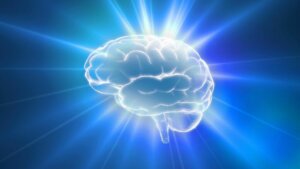Can the Brain Feel Pain?

Can the brain feel pain? Does it serve another function? And what is pain anyway?
Pain is the perception of an annoying and unpleasant sensation. There are many types of pain, starting with physical pain and emotional pain. Pain is actually a form of protection.
Sometimes, the cerebral cortex is the one that examines the type of pain we are feeling, classifies it, and compares it with another type of pain. The thalamus is the brain structure responsible for sending that sensation of pain to the limbic system, in the case of emotional pain.
When we feel a headache, for example, it’s normal for us to ask ourselves the following: Is it actually our head that’s hurting? Is it the skull? Is it the brain? The fact of the matter is that the brain is the organ in charge of interpreting and processing painful stimuli, but that doesn’t mean that it can feel pain. Find out more about it here!
Can the brain feel pain?

As we said before, even though the brain is the organ that sends pain sensations to the rest of the body, the reality is that the brain itself cannot feel pain. But there are nuances here. Even though the brain is unable to “feel” this sensation, the areas around it can “feel” it. These areas include the meninges, nerve tissues, and blood vessels.
Thus, when any of these areas suffer a type of trauma or pressure, we feel headaches, although, we repeat, it isn’t the brain that feels all this, although it can capture it. How? By receiving signals from receptors located in different parts of the body. These signals travel through the spinal cord and end in the brain (the thalamus).
The thalamus is the brain structure located in the center of the brain, above the hypothalamus. It is responsible, among other things, for directing the sensation of pain to other parts of the brain so that they translate them into the “correct” reaction, for example: fever, cold, pain, etc.
The brain doesn’t contain pain receptors
We’re going to delve a little more into the question of whether the brain can feel pain. Even though we know that it can’t, we’d still like to shed a little more light on the question. Pain receptors are called nociceptors, brain structures associated with the possibility of feeling something.
When a stimulus from the external or internal environment activates a nociceptor, the sensation of pain occurs. Thus, when a nociceptor is stimulated (for example when we touch something hot), the structure transmits the pain signal to the brain through the spinal cord.
We find nociceptors in our body (in different organs) and also outside it (in the skin, for example). It’s curious that there are no pain receptors in the brain, and that nociceptors are located in other tissues. This is another reason to help us understand why the brain cannot feel pain.
It doesn’t feel pain, but does perceive and interpret
The brain receives the information that comes from the nociceptors distributed throughout the body and interprets it, but doesn’t “feel” it as painful.
On the other hand, the neighboring structures of the brain, as we have already mentioned before, do contain nociceptors (for example the meninges).
One of the advantages of the brain not containing nociceptors is that this means it can be operated on just with local anesthesia, as it happens in many types of surgery. We’ll tell you more about it in the next section.
Usefulness in brain surgeries

The fact that the brain doesn’t feel pain can be helpful in some cases. For example, in surgical interventions (neurosurgery).
Here the skull is fixed to a structure with screws to prevent the person from moving, and only local anesthesia is applied to the external areas that reach the brain.
The person is awake and alert, and, in this way, the surgeon can obtain immediate information from the patient about the intervention itself.
The brain doesn’t feel pain, but does interpret its signal
As we have seen, although the brain cannot feel pain, it can interpret it. That is, it interprets the signals it receives from the nociceptors distributed throughout the body.
Thus, many neurologists believe that it would be correct to say that the brain “generates” pain, as it’s the one that ultimately tells us that something is hurting us.
Nociceptors, upon detecting a physical, chemical or thermal change, or some type of pressure, send a warning to the brain. The spinal cord is the structure through which information circulates, from the receptor, and that’s where it reaches the brain so that it can be interpreted as painful information.
Thus, the brain interprets that information and “decides” that it is pain. What do you do once you have interpreted the information? Well, this response is conditioned by who we are, what we’re like, and by our experiences.
In this way, our brain devices a course of action, For example, if we have detected a dangerous stimulus (pain), it’s likely that the order issued by the brain (circulating, once again, through the spinal cord) will be to remove your hand, to run, or to take evasive action, etc.
What about headaches?
Headaches can originate in different areas: in the skin of the head, in the meninges, in the arteries of the skull, or in the muscles of the neck (through a cervical contracture). What happens when that pain originates? That the brain interprets these signals and “decides” if it is pain or something else.
In the case of migraines, a specific type of headache, its origin is often found in the blood flow.
Thus, when the circulation in the veins or arteries of the head is disturbed, the nociceptors of the vessels warn the brain. This would explain why some headache medications are based on a modification of vasoconstriction.
Not everything is what it seems
In short, although the brain can’t feel pain, it can “originate” and interpret it. It is we, the people, who feel both physical and emotional pain.
This can make us “feel” that the brain feels it too, although in reality this isn’t the case. In addition, brain tissue connects us with the outside world through pain perception, and in turn, the brain allows us to interpret our internal environment through the nociceptors of the organs.
Pain can be felt so intensely that we can’t dissociate which part of us is feeling it, because we feel it “as a whole.” And the brain has a lot to do with all this, even if it doesn’t feel it directly.
Through the brain we interpret emotions, gestures, sensations, actions… which connects us, very often, with the pain of life’s experiences.
Can the brain feel pain? Does it serve another function? And what is pain anyway?
Pain is the perception of an annoying and unpleasant sensation. There are many types of pain, starting with physical pain and emotional pain. Pain is actually a form of protection.
Sometimes, the cerebral cortex is the one that examines the type of pain we are feeling, classifies it, and compares it with another type of pain. The thalamus is the brain structure responsible for sending that sensation of pain to the limbic system, in the case of emotional pain.
When we feel a headache, for example, it’s normal for us to ask ourselves the following: Is it actually our head that’s hurting? Is it the skull? Is it the brain? The fact of the matter is that the brain is the organ in charge of interpreting and processing painful stimuli, but that doesn’t mean that it can feel pain. Find out more about it here!
Can the brain feel pain?

As we said before, even though the brain is the organ that sends pain sensations to the rest of the body, the reality is that the brain itself cannot feel pain. But there are nuances here. Even though the brain is unable to “feel” this sensation, the areas around it can “feel” it. These areas include the meninges, nerve tissues, and blood vessels.
Thus, when any of these areas suffer a type of trauma or pressure, we feel headaches, although, we repeat, it isn’t the brain that feels all this, although it can capture it. How? By receiving signals from receptors located in different parts of the body. These signals travel through the spinal cord and end in the brain (the thalamus).
The thalamus is the brain structure located in the center of the brain, above the hypothalamus. It is responsible, among other things, for directing the sensation of pain to other parts of the brain so that they translate them into the “correct” reaction, for example: fever, cold, pain, etc.
The brain doesn’t contain pain receptors
We’re going to delve a little more into the question of whether the brain can feel pain. Even though we know that it can’t, we’d still like to shed a little more light on the question. Pain receptors are called nociceptors, brain structures associated with the possibility of feeling something.
When a stimulus from the external or internal environment activates a nociceptor, the sensation of pain occurs. Thus, when a nociceptor is stimulated (for example when we touch something hot), the structure transmits the pain signal to the brain through the spinal cord.
We find nociceptors in our body (in different organs) and also outside it (in the skin, for example). It’s curious that there are no pain receptors in the brain, and that nociceptors are located in other tissues. This is another reason to help us understand why the brain cannot feel pain.
It doesn’t feel pain, but does perceive and interpret
The brain receives the information that comes from the nociceptors distributed throughout the body and interprets it, but doesn’t “feel” it as painful.
On the other hand, the neighboring structures of the brain, as we have already mentioned before, do contain nociceptors (for example the meninges).
One of the advantages of the brain not containing nociceptors is that this means it can be operated on just with local anesthesia, as it happens in many types of surgery. We’ll tell you more about it in the next section.
Usefulness in brain surgeries

The fact that the brain doesn’t feel pain can be helpful in some cases. For example, in surgical interventions (neurosurgery).
Here the skull is fixed to a structure with screws to prevent the person from moving, and only local anesthesia is applied to the external areas that reach the brain.
The person is awake and alert, and, in this way, the surgeon can obtain immediate information from the patient about the intervention itself.
The brain doesn’t feel pain, but does interpret its signal
As we have seen, although the brain cannot feel pain, it can interpret it. That is, it interprets the signals it receives from the nociceptors distributed throughout the body.
Thus, many neurologists believe that it would be correct to say that the brain “generates” pain, as it’s the one that ultimately tells us that something is hurting us.
Nociceptors, upon detecting a physical, chemical or thermal change, or some type of pressure, send a warning to the brain. The spinal cord is the structure through which information circulates, from the receptor, and that’s where it reaches the brain so that it can be interpreted as painful information.
Thus, the brain interprets that information and “decides” that it is pain. What do you do once you have interpreted the information? Well, this response is conditioned by who we are, what we’re like, and by our experiences.
In this way, our brain devices a course of action, For example, if we have detected a dangerous stimulus (pain), it’s likely that the order issued by the brain (circulating, once again, through the spinal cord) will be to remove your hand, to run, or to take evasive action, etc.
What about headaches?
Headaches can originate in different areas: in the skin of the head, in the meninges, in the arteries of the skull, or in the muscles of the neck (through a cervical contracture). What happens when that pain originates? That the brain interprets these signals and “decides” if it is pain or something else.
In the case of migraines, a specific type of headache, its origin is often found in the blood flow.
Thus, when the circulation in the veins or arteries of the head is disturbed, the nociceptors of the vessels warn the brain. This would explain why some headache medications are based on a modification of vasoconstriction.
Not everything is what it seems
In short, although the brain can’t feel pain, it can “originate” and interpret it. It is we, the people, who feel both physical and emotional pain.
This can make us “feel” that the brain feels it too, although in reality this isn’t the case. In addition, brain tissue connects us with the outside world through pain perception, and in turn, the brain allows us to interpret our internal environment through the nociceptors of the organs.
Pain can be felt so intensely that we can’t dissociate which part of us is feeling it, because we feel it “as a whole.” And the brain has a lot to do with all this, even if it doesn’t feel it directly.
Through the brain we interpret emotions, gestures, sensations, actions… which connects us, very often, with the pain of life’s experiences.
-
Bear, M.F.; Connors, B.W. y Paradiso, M.A. (1998). Neurociencia. Explorando el cerebro. Madrid: Masson.
-
Cardinali, D. P. (1991). Manual de neurofisiología. Ediciones Díaz de Santos, S.A.
-
Carlson, N.R. (2002). Fisiología de la conducta. . Barcelona: Ariel.
-
Del Abril A.; Ambrosio, E.; De Blas, R.; Caminero, A.A.; García, C.; De Pablo, J.M. y Sandoval, E. (2001). Fundamentos biológicos de la conducta. Capítulos 6, 7, 12, 13, 18. Madrid: Sanz y Torres.
-
Patel, N., & Kirmi, O. (2009). Anatomy and imaging of the normal meninges. In Seminars in Ultrasound, CT and MRI (Vol. 30, No. 6, pp. 559-564). WB Saunders.
- Perea-Bartolomé, M.V. y Ladera-Fernández, V. (2004). El tálamo: aspectos neurofuncionales. Rev neurol, 38(7): 687-693.
Este texto se ofrece únicamente con propósitos informativos y no reemplaza la consulta con un profesional. Ante dudas, consulta a tu especialista.







